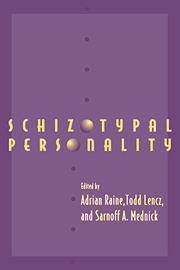Book contents
- Frontmatter
- Contents
- List of contributors
- Preface
- Acknowledgments
- Part I Introduction
- Part II Genetics and neurodevelopment
- Part III Assessment
- Part IV Categorical versus dimensional approaches
- Part V Psychophysiology and psychopharmacology
- Part VI Neuropsychology
- 13 Neuropsychological abnormalities associated with schizotypal personality
- 14 Syndromes of schizotypy: patterns of cognitive asymmetry, arousal, and gender
- 15 Working memory deficits, antisaccades, and thought disorder in relation to perceptual aberration
- Part VII Brain imaging
- Part VIII Conclusion
- Part IX Appendix
- Name Index
- Subject Index
14 - Syndromes of schizotypy: patterns of cognitive asymmetry, arousal, and gender
from Part VI - Neuropsychology
Published online by Cambridge University Press: 04 August 2010
- Frontmatter
- Contents
- List of contributors
- Preface
- Acknowledgments
- Part I Introduction
- Part II Genetics and neurodevelopment
- Part III Assessment
- Part IV Categorical versus dimensional approaches
- Part V Psychophysiology and psychopharmacology
- Part VI Neuropsychology
- 13 Neuropsychological abnormalities associated with schizotypal personality
- 14 Syndromes of schizotypy: patterns of cognitive asymmetry, arousal, and gender
- 15 Working memory deficits, antisaccades, and thought disorder in relation to perceptual aberration
- Part VII Brain imaging
- Part VIII Conclusion
- Part IX Appendix
- Name Index
- Subject Index
Summary
In this chapter we describe two experiments in which we approach the nature and central nervous system basis of the schizotypal personality from the perspective of schizophrenia. From a series of experiments (Gruzelier, 1991b; 1994) we have evolved a three-syndrome neuropsychophysiological model of acute schizophrenia, two syndromes of which have a basis in imbalances in hemispheric activation, whereas the third is not consistently associated with lateral asymmetry. Here we show that schizotypy has a similar three-syndrome structure of core features, and we provide preliminary evidence of a similar basis in hemispheric asymmetry as found in schizophrenia. This account provides unambiguous evidence of a dimensional rather than categorical view of the relationship between schizotypy and schizophrenia, in keeping with genetic evidence (Claridge, 1985), and, given that our results were obtained from healthy, high achieving medical students, provides support for the dimensional view of schizotypy and normality. It describes a syndromal model of schizotypy that offers a theoretical framework for the nature and neuropsychophysiological basis of the syndromes, too often investigated from an operational or atheoretical perspective. Finally, by monitoring arousal and stress levels from self-report questionnaires, and by utilizing an ecologically valid stressor, test anxiety, we gain insights about how schizotypy may progress to schizophrenia, results that endorse the importance of extremes of arousal in the dynamics of schizotypy and schizophrenia.
Three-syndrome model of schizophrenia
In acute schizophrenia we have found three syndromes derived from a comprehensive clinical evaluation with the Present State Evaluation (Wing, Cooper, & Satorius, 1974) and the Brief Psychiatric Rating Scale (BPRS) (Overall & Gorham, 1962).
Keywords
- Type
- Chapter
- Information
- Schizotypal Personality , pp. 329 - 352Publisher: Cambridge University PressPrint publication year: 1995
- 2
- Cited by



